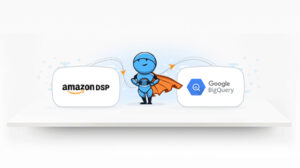Amazon is a beast of an eCommerce platform because of the breadth of services and integration it offers developers. Amazon’s APIs make this possible, giving third parties technical access to specific parts of the site to create new tools, software, and integrations. To stay ahead of the curve and accommodate customers’ changing needs, Amazon continues to introduce new APIs regularly.
This post will dive into what APIs are, why they are essential, and which ones you should know about if you want to integrate with Amazon services as a third-party developer. We will assist in empowering your e-commerce company, everything from Amazon’s cloud business to Ads, to unlock your full potential for digital transformation. Learn how it works!
What is Amazon Application Program Interface (Amazon API)?
API stands for Application Programming Interface. Regarding Amazon APIs, the word Application refers to any software with a distinct function. The interface can be thought of as a contract of service between two applications. The programming functionality defines how the two applications communicate with each other using requests and responses and will highlight how their API documentation provides crucial information to developers who structure those requests and responses.
What is Amazon API Gateway?
On July 9, 2015, AWS launched the Amazon API gateway that enables developers to develop, test, market, monitor, and secure APIs of any scale. This fully managed service by Amazon allows the HTTP endpoint definition of a WebSocket API or REST API and communicates those to business logic in the backend. The Amazon API Gateway handles the load of accepting and processing thousands of synchronous API calls, including:
- Traffic management
- Authorization and access control
- CORS Support
- Throttling and monitoring
- API version management
Why is an Amazon API important?
Amazon API is essential because it is the only external connection or interface to the computing services and resources. It is necessary to realize that the Amazon API is needed for transactions.
How does Amazon API work?
Amazon released its API so that developers could get easier access to Amazon’s product information. By using the Amazon API, a third-party website can publish direct links to Amazon products with updated prices and a choice to “buy now.” An Amazon API is not a user interface but a software-to-software interface. With Amazon API, applications communicate with each other without needing user knowledge or intervention.
For example, when you buy movie tickets online and enter your credit card information, the movie theatre website uses an API to send your credit card details to a remote application that verifies whether your data is authentic or not. Once payment is approved and confirmed, the remote application will affirm and send a response to the movie ticket website saying it is “OK” to issue the tickets. As a user, you only see one interface, the movie ticket Web site, but many applications work together using APIs behind the scenes. This type of integration is called “Seamless.” The user is unaware of how and when software functions are handed over from one application to another.
Amazon API resembles Software as a Service (SaaS) since software developers do not have to start from scratch every time they write a program. Instead of building one core application that tries everything like e-mail, billing, tracking, etc., the same application can contract out specific responsibilities to remote software that does it better.
How do I use an Amazon API?
- First, you must create an HTTP API using the AWS Management Console.
- Then navigate to the API Gateway console.
- Next, you need to choose “Create API.”
- Then, under HTTP API, choose “Build.”
- Later, choose “Add integration.”
- Then select an “AWS Lambda function” or enter an “HTTP endpoint.”
- The next step is for the “Name” option, enter a name for your API.
- Next, you must choose “Review” and create.
- Lastly, you must choose “Create.”
How does Amazon charge for the Amazon API?
Two Amazon APIs are free and carry data relating to eCommerce. The Amazon Product Advertising API and Amazon Marketplace Web Services API are these Amazon APIs. With Amazon API Gateway, you only pay when using your Amazon APIs. There are no minimum fees or upfront commitments. For HTTP APIs and REST APIs, you pay only for the Amazon API calls you receive, and the amount of data transferred.
What are the different types of Amazon APIs?
There are nine types of Amazon APIs, as Amazon APIs act as the “Entrance Way” for applications to access business nuances, essential data, or relevant components from your backend facilities.
Amazon Selling Partner API (Amazon SP API)
The Amazon SP API is a REST-based architectural style released by Amazon. A REST API (also known as RESTful API) conforms to the constraints of REST architectural style and allows for interaction with RESTful web services. Amazon Selling Partner API (Amazon SP API) enables access to
- Critical data programmatically for software applications, such as orders, payments, listings, reports, etc.
- Discover insights into key performing areas, and selling efficiency, and make more sense of their data as it will help in knowing when customers are likely to optimize ad spend, make effective inventory management decisions, purchase, publicity campaigns, and exclusive offers.
Amazon SP API is offering all its Selling Partners and third-party developers several of the latest improvements over MWS, such as innovative, JSON-based REST API design standards, OAuth2.0 selling partner authorization using Login with Amazon, and a test endpoint – the most requested and favored feature in MWS. On September 6th, 2021, Amazon SP API replaced the legacy Amazon MWS API. In addition to all legacy functionality previously provided in Amazon MWS, Amazon SP API provides capabilities for vendors.
Amazon SP API supports the first-ever APIs for Amazon Vendors through the same API control plane and authorization procedures. From now on, all new APIs components will be built in Amazon SP-API, with updates to Amazon MWS only to support necessary changes needed for the business. It is a global Amazon API supporting North America (Canada, US, Mexico, and Brazil marketplaces), Europe (Spain, UK, France, Netherlands, Germany, Italy, Sweden, Poland, Turkey marketplaces), Asia (UAE and India marketplaces), and far East (Singapore, Australia, and Japan marketplaces).
Amazon Market Web Services API (Amazon MWS API)
Amazon Marketplace Web Service is an amalgamated web service API that helps Amazon sellers programmatically exchange data on orders, listings, reports, payments, and more. Data integration with Amazon facilitates elevated levels of selling automation, which will help sellers develop and grow their businesses. Using Amazon MWS, sellers can increase selling efficiency, reduce labor requirements, and improve customer response time. There are no fees associated with Amazon MWS. Still, to use the Amazon MWS API, you must have an Amazon Market Place Web Services (Amazon MWS)-eligible seller account and register to use Amazon MWS.
Amazon Sponsored Brands Application Program Interface (Amazon Sponsored Brands API)
Amazon Sponsored Brands (previously known as Headline Search Ads) are banner ads that will help access programmatically and facilitate the management of advertising campaigns with Amazon’s advertising API. This will include a brand’s logo, message, and products in Amazon’s search results.
Amazon Sponsored Brands is a robust tool for users with the development resources to manage the implementation and versioning updates. These ads have chronologically been keyword-based and will be displayed across the top of the search results, making them valuable for reaching shoppers instantly in the buyer’s quest.
Sponsored Brands can help an upcoming brand and engage shoppers as they browse and discover products on Amazon. A more established brand might use Sponsored Brands to rank high and increase brand loyalty for Amazon shoppers. Amazon Sponsored Brand will enjoy getting all the needed help. It can open doors to repeat business by using Sponsored Brands ads to send customers to stores, providing opportunities for them to find additional products in the catalog that they might be interested in.
Amazon Sponsored Brands also offers unique reporting with new brand metrics to measure the number of first-time customers or total first-time sales a particular brand acquired on Amazon for the entire year.
Amazon Sponsored Display Application Program Interface (Amazon Sponsored Display API)
The Amazon Ads API for Sponsored Display enables integrators to programmatically access Sponsored Display (SD) to build applications to automate, scale, and optimize SD campaigns. The API is described using an open API specification, an industry standard for describing API services.
Amazon Sponsored Display is a self-service advertising product that generates ad creative automatically, and campaigns can be launched quickly. Sponsored Display ads are purchased on a CPC basis. Amazon DSP is a demand-side platform allowing advertisers to buy ads at scale programmatically.
Amazon Sponsored Display API is based on the HTTP protocol, with GET, POST, PUT, and DELETE operations. The API aligns with RESTful design principles to align HTTP methods with corresponding actions. For example, the HTTP GET works functionally to retrieve resources, which can potentially be cached for performance benefits. The HTTP POST operation is explicitly designed to create resources, while the PUT operation is meant to update resources. The HTTP DELETE operation functionally works to archive the resources. The Amazon Ads API for Sponsored Display enables integrators to programmatically access Sponsored Display (SD) to build applications to automate, scale, and optimize SD campaigns. The API is described using an open API specification, an industry standard for describing API services.
Amazon Sponsored Products Application Program Interface (Amazon Sponsored Products API)
The Amazon Sponsored Products API allows users to create flexible solutions to suit their needs, and goals and helps in deeper integration with Amazon Advertising. You can control your costs as Sponsored Ads are Cost-Per-Click (CPC), so you only pay when customers click your ads. This will help you choose how much to bid per click and set your budget.
Amazon Sponsored Products API will enable you to:
- Advertise your products as you can help customers find your products by quickly creating ads that appear in related shopping results and product pages.
- Showcases most advertising console functionality while enabling developer’s management, allowing advertisers to optimize their marketing campaigns or numerous campaigns based on pre-determined conditions.
Amazon Brand Metrics Open Beta
Brand Metrics (beta) provides a new measurement solution that quantifies opportunities for your brand at each stage of the customer journey in Amazon’s store and helps brands understand the value of different shopping engagements that impact stages of that journey. You can now access awareness and consideration indices that compare your performance to peers predictive of consideration and sales.
Brand Metrics (beta) also breaks out critical shopping engagements at each stage of the shopping journey, along with the return on engagement, so that you can measure the historical sales following a consideration event or purchase.
Brand Metrics Open Beta can help provide the insights you need to understand and optimize your advertising. With Brand Metrics Open Beta, you can:
Measure
You can measure the impact of your upper and mid-funnel tactics, see how shoppers respond, and reveal an interest in your brand throughout the marketing campaigns.
Evaluate
You can evaluate the value of shopping engagements by looking at sales generated over a 12-month lookback period.
Optimize
You can optimize your organic marketing and advertising efforts in Amazon’s store to engage more shoppers and build your brand.
Monitor
You can also monitor your performance relative to your category and peers at each stage of the purchase journey.
Amazon Demand Side Platform (Amazon DSP)
The Amazon DSP API provides programmatic access to Amazon’s DSP for self-service customers. This API enables customers who are planning to advertise their products and helps them go through the process in pre-determined programmatic access to buy exhibits, video-featured, and audio-enabled ads through the Amazon website and off-website too.
Using Amazon DSP,
- You can reach audiences across the web on both Amazon sites and apps and through publishing partners and third-party exchanges.
- Enable businesses that build applications and software solutions to automate and
- Optimize advertising on behalf of others who can access the Amazon Ads API as a third party.
- Automate, scale, and optimize advertising activities and reporting.
Amazon DSP API functionality for Campaign Management is available for display and video ads in beta in the US, Canada, Mexico, and Brazil. API functionality for Reporting is available for customers in the US, CA, MX, DE, ES, FR, IT, ES, NL, UK, AU, IN, JP, and UAE. To access API, you must first request registration to access the Amazon Ads API on behalf of your advertising account.
Amazon Attribution Application Program Interface (Amazon Attribution API)
Amazon Attribution API is an analytics and advertising measurement product that will throw light on the measurement of product performance concerning advertising. This will enable advertisers to understand the impact of their non-Amazon marketing strategies on driving Amazon shopping activity.
Advertising is measured by including attribution tags on non-Amazon media across paid and organic channels, including search, social, display, video, email, third-party affiliate marketing, and more.
The Amazon Attribution API enables integrators to quickly set up Amazon Attribution tags, which can measure media linking to an Amazon online store or a relevant product detail page. The API also enables programmatic reporting on clicks and click-attributed conversion metrics so users can understand the performance and impact of their tagged media.
Important Note: Amazon Attribution is available in beta to professional sellers enrolled in Amazon Brand Registry and vendors that sell products on Amazon in the following markets: US, Canada, UK, Germany, France, Italy, and Spain.
Amazon Catalog Application Program Interface (Amazon Catalog API)
Amazon Catalog API will allow programmatic access to search and retrieve the output/product details from Amazon’s archive. If you are having trouble finding information on the API, that is because the web service has undergone two name changes in recent history: it was also known as ECS (Elastic Container Services) and AWS (Amazon Web Services).
Amazon Product Advertising Application Program Interface (Amazon Product Advertising API)
Amazon Product Advertising API is a web-based service provider and an API that gives application Programs access to Amazon’s product catalog data. Amazon API is available in either the SOAP (Simple Object Access Protocol or REST protocols (Representational State Transfer). It facilitates products to be listed and/or sold through third-party applications and websites. Amazon Product Advertising API is Amazon-owned and developed and is not a product of Amazon Web Services or (Amazon AWS).
Amazon developed the Product Advertising API for three classifications of users, namely Associates, vendors, and developers. Associates are third-party owners wishing to build more effective sponsored affiliate links to Amazon products. Vendors are sellers on the Amazon platform looking to manage inventory and receive batch, and product data feeds. At the same time, developers are functioning for building Amazon-driven functionality into their applications. The vendors use the Amazon API to search for products’ catalogs and retrieve information on products, images, and reviews. A third group that benefits from Amazon API is the developers. Thus, Amazon API aids developers in the creation, publishing, and monitoring of the APIs. You can only use the Product Advertising API for the marketplace that you are registered for as an Amazon Associate. For example, you cannot use the German marketplace API in the US marketplace if you are in a German marketplace.
Conclusion
This blog provides insight into how Amazon API will help businesses grow. You can bring all your Amazon business into a data warehouse of your choice to monitor and analyze your business data. With the help of these Amazon APIs and our eCommerce-focused Data pipeline (Daton) ensure you always have the correct data at the right time. Request a demo and envision how reporting is supercharged with a 360° view.













